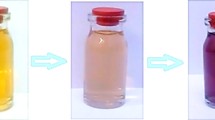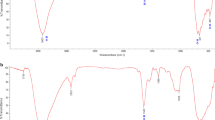Abstract
This article describes a new type of core–shell pattern Fe3O4 nanoparticle (Au/CS-agar@Fe3O4) that was developed using Au NPs and chitosan-agarose composite. Our goal in catalytic exploration was to synthesize 5-substituted-1H-tetrazoles via click synthesis using aryl halides. By this method, using K4[Fe(CN)6] as a nontoxic CN resource, we treated a variety of aryl halides (Cl, Br, and I) using the highly effective and reusable Au/CS-agar@Fe3O4 catalyst, catalyzing the [3 + 2]-cycloaddition of the corresponding aryl nitriles with NaN3 to the successive one-pot solvent-free preparation at 120 °C of 5-substituted-1H-tetrazoles. The various substrates provided a yield in the range of 70–96% after the reaction of 12 h. The catalyst's robustness was supported by tests for leaching, hot filtration, and catalyst reusability nine times in a row. In the medicinal part, the anticancer properties of Au/CS-agar@Fe3O4 nanocomposite against lung cancer cell lines were determined. In vitro experiments, after 3–4 passages, the cancer cells (NCI-H1563, NCI-H1573, NCI-H1975, and NCI-H661) and normal cell (HUVEC) were prepared in terms of morphology and number. After segregating the cells from the flask surface by trypsin–EDTA, cell viability was assessed and counted, and 3 × 103 cells were cultured with or without nanoparticles in 96 wells. IC50 of Au/CS-agar@Fe3O4 nanocomposite was 160, 173, 142, and 212 on NCI-H1563, NCI-H1573, NCI-H1975, and NCI-H661 cancer cells. In this study, the highest antioxidant efficacy on DPPH was reported approximately 100% at 1000 μg/ml. The antioxidant IC50 of Au/CS-agar@Fe3O4 nanocomposite was 254 µg/mL.















Similar content being viewed by others
Data Availability
The authors declare that the data can be available on request to the authors.
References
Levenson AS, Jordan VC (1997) MCF-7: the first hormone-responsive breast cancer cell line. Cancer Res 57(15):3071–3078
Kirikoshi H, Katoh M (2002) Expression of WNT7A in human normal tissues and cancer, and regulation of WNT7A and WNT7B in human cancer. Int J Oncol 21(4):895–900
Mehta RG, Murillo G, Naithani R, Peng X (2010) Cancer chemoprevention by natural products: how far have we come? Pharm Res 27(6):950–961
Beyene HD, Werkneh AA, Bezabh HK, Ambaye TG (2017) Sustain Mater Technol 13:18–23
Kosha A, Farahbakhsh M, Hakimi S, Abdollahi L, Golzari M, Seif M (2010) Epidemiology of cancer in west Azarbaijan in 2007. Med J Tabriz Univ Med Sci 32(4):74–79 ([Farsi])
Shahneh FZ, Valiyari S, Azadmehr A, Hajiaghaee R, Yaripour S, Bandehagh A et al (2013) Inhibition of growth and induction of apoptosis in fibrosarcoma cell lines by Echinophora platyloba DC: In Vitro Analysis. Adv Pharmacol Sci 2013:512931
He J, Feizipour S, Veisi H, Amirpour Amraii S, Zangeneh MM, Hemmati H (2024) Panax ginseng root aqueous extract mediated biosynthesis of silver nanoparticles under ultrasound condition and investigation of the treatment of human lung adenocarcinoma with following the PI3K/AKT/mTOR signaling pathway. Inorg Chem Commun 160:112021
Rajeshkumar S (2016) Anticancer activity of eco-friendly gold nanoparticles against lung and liver cancer cells. J Genet Eng Biotechnol 14(1):195–202
Jain S, Hirst DG, O’Sullivan JM (2012) Gold nanoparticles as novel agents for cancer therapy. Br J Radiol 85(1010):101–113
Chithrani DB, Jelveh S, Jalali F, van Prooijen M, Allen C, Bristow RG et al (2010) Gold nanoparticles as radiation sensitizers in cancer therapy. Radiat Res 173:719–728
Rahman WN, Bishara N, Ackerly T, He CF, Jackson P, Wong C et al (2009) Enhancement of radiation effects by gold nanoparticles for superficial radiation therapy. Nanomedicine 5:136–142
Hainfeld JF, Dilmanian FA, Zhong Z, Slatkin DN, Kalef-Ezra JA, Smilowitz HM (2010) Gold nanoparticles enhance the radiation therapy of a murine squamous cell carcinoma. Phys Med Biol 55:3045–3059
Zhang X, Xing JZ, Chen J, Ko L, Amanie J, Gulavita S et al (2008) Enhanced radiation sensitivity in prostate cancer by gold-nanoparticles. Clin Invest Med 31:E160
Kong T, Zeng J, Wang X, Yang X, Yang J, McQuarrie S et al (2008) Enhancement of radiation cytotoxicity in breast-cancer cells by localized attachment of gold nanoparticles. Small 4:1537–1543
Roa W, Zhang X, Guo L, Shaw A, Hu X, Xiong Y et al (2009) Gold nanoparticle sensitize radiotherapy of prostate cancer cells by regulation of the cell cycle. Nanotechnology 20:375101
Chien CC, Wang CH, Hua TE, Tseng PY, Yang TY, Hwu Y et al (2007) Synchrotron X-ray synthesized gold nanoparticles for tumour therapy, synchrotron radiation instrumentation: ninth international conference, 1908–1911
Vaidya JS, Joseph DJ, Tobias JS, Bulsara M, Wenz F, Saunders C et al (2010) Targeted intraoperative radiotherapy versus whole breast radiotherapy for breast cancer (TARGIT-A trial): an international, prospective, randomised, non-inferiority phase 3 trial. Lancet 376:91–102
Morton GC (2005) The emerging role of high-dose-rate brachytherapy for prostate cancer. Clin Oncol 17:219–227
Al-Azmi A, Keshipour S (2020) Dimaval as an efficient ligand for binding Ru(III) on cross-linked chitosan aerogel: synthesis, characterization and catalytic investigation. Cellulose 27:895–904
Nemati M, Tamoradi T, Veisi H (2019) Immobilization of Gd(III) complex on Fe3O4: a novel and recyclable catalyst for synthesis of tetrazole and S-S coupling. Polyhedron 167:75–84
Azimi F, Poursattar Marjani A, Keshipour S (2011) Fe(II)-phthalocyanine supported on chitosan aerogel as a catalyst for oxidation of alcohols and alkyl arenes. Sci Rep 11:23769
Eyvari-Ashnak F, Keshipour S (2023) Amines functionalities on chitosan boasting photocatalytic activity of cobalt(II)-phthalocyanine in water-splitting. Mol Catal 534:112820
Cai Y, Karmakar B, Salem MA, Alzahrani AA, Bani-Fwaz MZ, Oyouni AAA, Al-Amer O, Batiha G (2022) Ag NPs supported chitosan-agarose modified Fe3O4 nanocomposite catalyzed synthesis of indazolo[2,1-b]phthalazines and anticancer studies against liver and lung cancer cells. Int J Biol Macromol 208:20–28
Shi D, Karmakar B, Osman HH, El-kott AF, Morsy K, Abdel-Daim MM (2022) Arab J Chem 15:103471
Kesipour S, Adak K (2017) Magnetic d-penicillamine-functionalized cellulose as a new heterogeneous support for cobalt(II) in green oxidation of ethylbenzene to acetophenone. Appl Organomet Chem 31:e3774
Inaloo ID, Majnooni S (2019) A Fe3O4@SiO2/Schiff base/Pd complex as an efficient heterogeneous and recyclable nanocatalyst for one-pot domino synthesis of carbamates and unsymmetrical ureas. Eur J Org Chem 37:6359–6368
Inaloo ID, Majnooni S, Eslahi H, Esmaeilpour M (2020) Efficient nickel(II) immobilized on EDTA-modified Fe3O4@SiO2 nanospheres as a novel nanocatalyst for amination of heteroaryl carbamates and sulfamates through the cleavage of C-O bond. Mol Catal 492:110915
Sardarian AR, Zangiabadi M, Inaloo ID (2016) Fe3O4@SiO2/Schiff base/Pd complex as an efficient heterogeneous and recyclable nanocatalyst for chemoselective N-arylation of O-alkyl primary carbamates. RSc Adv 6(94):92057–92064
Inaloo ID, Majnooni S, Eslahi H, Esmaeilpour M (2020) Air-stable Fe3O4@SiO2-EDTA-Ni(0) as an efficient recyclable magnetic nanocatalyst for effective Suzuki-Miyaura and heck cross-coupling via aryl sulfamates and carbamates. Appl Organomet Chem 34(8):e5662
Sadeghzadeh SM, Zhiani R, Khoobi M, Emrani S (2018) Synthesis of 3-Acyloxylindolines under mild conditions using tripolyphosphate-grafted KCC-1-NH2. Micropor Mesopor Mater 257:147–153
Zhiani R, Saadati SM, Zahedifar M, Sadeghzadeh SM (2018) Synthesis of new class of copper(II) complex-based FeNi3/KCC-1 for the N-formylation of amines using dihydrogen and carbon dioxide. Catal Lett 148:2487–2500
Hassankhani A, Sadeghzadeh SM, Zhiani R (2018) C-C and C–H coupling reactions by Fe3O4/KCC-1/APTPOSS supported palladium-salen-bridged ionic networks as a reusable catalyst. RSc Adv 8(16):8761–8769
Fan L, Wang J, Sadeghzadeh SM, Zhiani R, Shahroudi M, Amarloo F (2019) Co-immobilization of laccase and TEMPO onto glycidyloxypropyl functionalized fibrous phosphosilicate nanoparticles for fixing CO2 into β-oxopropylcarbamatesin. Catal Lett 149:3465–3475
Sadeghzadeh SM (2016) Ionic liquid-modified fibrous silica microspheres loaded with PbS nanoparticles and their enhanced catalytic activity and reusability for the hydrogen production by selective dehydrogenation of formic acid. J Mol Liq 223:267–273
Sadeghzadeh SM (2015) Ultrasound-promoted green approach for the synthesis of thiazoloquinolines using gold (III) dipyridine complex immobilized on SBA-15 as nano catalysts at room temperature. RSC Adv 5(84):68947–68952
Zhan-Jiang Z, Wang D, Xu Z, Xu LW (2015) Synthesis of bi-and bis-1, 2, 3-triazoles by copper-catalyzed Huisgencycloaddition: a family of valuable products by click chemistry. Beilstein J Org Chem 11:2557
Jigpei H, Hu H, Zhang M, Hu X, Chen M, Chen D, Liu J, Xiao G, Wang Y, Wen Z (2017) A mini review of the synthesis of poly-1, 2, 3-triazole-based functional materials. RSC Adv 12:2281
Weiguo W, Peng X, Wei F, Tung CH, Xu Z (2016) Copper (I)-catalyzed interrupted click reaction: synthesis of diverse 5-hetero-functionalized triazoles. Ang Chem 128:659
Lahoucine B, Ayouchia HB, Anane H, Pascual-Álvarez A, De Munno G, Julve M, Stiriba SE (2019) A reusable polymer-supported copper (I) catalyst for triazole click reaction on water: an experimental and computational study. Appl Organomet Chem 33:4669
Hein JE, Fokin VV (2010) Copper-catalyzed azide–alkyne cycloaddition (CuAAC) and beyond: new reactivity of copper (I) acetylides. Chem Soc Rev 39:1302
Saeidian H, Vahdati S, Mirjafary Z, Eftekhari B (2018) Immobilized copper nanoparticles on nitrogen-rich porous activated carbon from egg white biomass: a robust hydrophilic–hydrophobic balance catalyst for click reaction. RSC Adv 8:38801
Giffin MJ, Heaslet H, Brik A, Lin YC, Cauvi G, Wong CH, McRee DE, Elder JH, Stout CD, Torbett BE (2008) A copper (I)-catalyzed 1, 2, 3-triazole azide-alkyne click compound is a potent inhibitor of a multidrug-resistant HIV-1 protease variant. J Med Chem 51:6263
Struthers H, Mindt TL, Schibli R (2010) Metal chelating systems synthesized using the copper (I) catalyzed azide-alkyne cycloaddition. Dalton trans 39:675
Cornelissen JP, Van Diemen JH, Groeneveld LR, Haasnoot JG, Spek AL, Reedijk J (1992) Synthesis and properties of isostructural transition-metal (copper, nickel, cobalt, and iron) compounds with 7, 7’, 8, 8’-tetracyanoquinodimethanide (1-) in an unusual monodentate coordination mode: crystal structure of bis (3, 5-bis (pyridin-2-yl)-4-amino-1, 2, 4-triazole) bis (7, 7’, 8, 8’-tetracyanoquinodimethanido) copper (II). Inorg Chem 31:198
Gonzalez-Olvera R, Urquiza-Castro C, Lara V, Santillan R, Morales-Serna J (2016) Cu–Al mixed oxide catalysts for azide–alkyne 1, 3-cycloaddition in ethanol–water. RSC Adv 6:63660
Hosseinnejad T, Fattahi B, Heravi MM (2015) Computational studies on the regioselectivity of metal-catalyzed synthesis of 1, 2, 3 triazoles via click reaction: a review. J Mol Model 21:264
Estela H, Nicasio MC, Pérez PJ (2015) Copper-catalysedazide–alkyne cycloadditions (CuAAC): an update. Org biomol Chem 13:9528–9550
Leilan AH, Babazadeh M, Hekmati M, Ghasemi E (2022) Inorg Chem Commun 141:109566
Meng M, Xue D (2020) Green immobilized Ag NPs over magnetic Fe3O4 NPs using Pomegranate juice induces apoptosis via P53 and signal transducer and activator of transcription 3 signaling pathways in human gastric cancer cells. Inorg Chem Commun 146:110159
Nasrollahzadeh M, Ghorbannezhad F, Sajadi SM (2019) Biosynthesis of Pd/MnO2 nanocomposite using Solanum melongena plant extract and its application for the one-pot synthesis of 5-substituted 1H-tetrazoles from aryl halides. Appl Organomet Chem 33:e4698
Sajjadi M, Nasrollahzadeh M, Ghafuri H, Baran T, Orooji Y, Baran NY, Shokouhimehr M (2022) Modified chitosan-zeolite supported Pd nanoparticles: A reusable catalyst for the synthesis of 5-substituted-1H-tetrazoles from aryl halides. Int J Biol Macromol 209:1573–1585
Alterman M, Hallberg A (2000) Fast microwave-assisted preparation of aryl and vinyl nitriles and the corresponding tetrazoles from organo-halides. J Org Chem 65:7984
Prajapti SK, Nagarsenkar A, Babu BN (2014) An efficient synthesis of 5-substituted 1H-tetrazoles via B(C6F5)3 catalyzed [3+2] cycloaddition of nitriles and sodium azide. Tetrahedron Lett 55(24):3507
Coca A, Turek E (2014) Synthesis of 5-substituted 1H-tetrazoles catalyzed by ytterbium triflate hydrate. Tetrahedron Lett 55(16):2718
Jin T, Kitahara F, Kamijo S, Yamamoto Y (2008) Copper-catalyzed synthesis of 5-substituted 1H-tetrazoles via the [3+2] cycloaddition of nitriles and trimethylsilyl azide. Tetrahedron Lett 49:2824
Demko ZP, Sharpless KB (2001) Preparation of 5-substituted 1H-tetrazoles from nitriles in water. J Org Chem 66:7945
Zhu Y, Ren Y, Cai C (2009) One-pot synthesis of 5-substituted 1H-tetrazoles from aryl bromides with potassium hexakis(cyano-κC)ferrate(4−) (K4[Fe(CN)6]) as cyanide source. Helvetica Chim Acta 92:171
Author information
Authors and Affiliations
Contributions
YS, BW, CZ: Visualization, Writing original draft, Formal analysis. YS, BW: Funding acquisition, Methodology, Supervision. BW, CZ: Writing original draft, Formal analysis, Writing-review and editing. All authors reviewed the manuscript.
Corresponding author
Ethics declarations
Conflict of interest
The authors declare that there is no conflict of interest with other people or organizations that could affect this study.
Additional information
Publisher's Note
Springer Nature remains neutral with regard to jurisdictional claims in published maps and institutional affiliations.
Rights and permissions
Springer Nature or its licensor (e.g. a society or other partner) holds exclusive rights to this article under a publishing agreement with the author(s) or other rightsholder(s); author self-archiving of the accepted manuscript version of this article is solely governed by the terms of such publishing agreement and applicable law.
About this article
Cite this article
Sheng, Y., Wu, B. & Zhang, C. Gold Nanoparticles Decorated Chitosan-Agarose Modified Magnetic Nanocomposite: Catalytic Application for the Preparation of Tetrazoles and Biological Evaluation for the Treatment of Lung Carcinoma. J Polym Environ (2024). https://doi.org/10.1007/s10924-024-03252-2
Accepted:
Published:
DOI: https://doi.org/10.1007/s10924-024-03252-2




